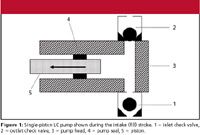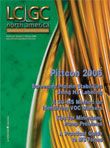Check Valve Problems
LCGC North America
Check valves are the number one problem area for most LC pumps.
Ask most users of liquid chromatography (LC) instrumentation what is the most problematic part of the system and you'll almost always get the same answer: "check valves." The check valves are a key component of the LC system, and, unfortunately, if they are not working perfectly, the pump performance is compromised. This month's installment of "LC Troubleshooting" takes a look at pump design, how check valves work, and what steps can be taken to minimize pump problems.

John W. Dolan
The Basic LC Pump
All LC pumps in use today are designed around the reciprocating piston model shown in Figure 1. In concept, the operation of the pump is quite simple. The pump comprises a piston, pump seal, and two check valves mounted in the pump head. The piston typically is made of sapphire and slides back and forth to move solvent through the pump. The pump seal is made of an inert polymer and generally contains a spring to give it better adhesion to the piston so that mobile phase leakage is minimized. Two check valves control the direction of flow through the pump and allow the pump to generate sufficient pressure to drive the mobile phase through the column. In Figure 1, the pump is shown in the intake or fill mode: the piston is withdrawn from the pump head, creating a low-pressure region inside the pump head. This allows the outlet check valve ball to settle onto the seat due to gravity and back pressure from the column. The low pressure inside the pump head and slight head pressure on the solvent (created as mobile phase siphons from the reservoir) lifts the inlet check valve ball from the seat, allowing mobile phase to fill the pump. In the delivery mode, the piston reverses direction, the increase in pressure drives the inlet check valve closed, and when the pressure exceeds the column pressure, the outlet check valve opens, allowing solvent to flow to the column.

Ball Valves
The check valves are essential for reliable pump operation. They must open and close quickly and easily and must provide a secure seal over a wide pressure range. The most common check valve design is the ball-and-seat configuration shown on the left in Figure 2. The seat typically is made of sapphire and the ball of ruby. This combination of materials has proven reliable for many years. The sealing surface is a very narrow ring where the ball and seat are in contact. This is analogous to a billiard ball sitting on a wine bottle, not a tennis ball on a bagel, where both components could deform slightly to help the sealing process. As a result, it takes very little contamination to disrupt the check valve seal. One fiber of dust is enough to cause the check valve to leak.
Several design modifications of the ball-type check valve have been made over the years in efforts to improve reliability. Two of the most popular alternatives are the dual-ball check valve and the spring-loaded check valve. The dual-ball valve comprises two ball-and-seat combinations in series in the same housing. The idea is that with two balls, only one has to seal for adequate pump operation, so the system should be twice as reliable. The detractors of this design say that the dual-ball valve has twice as many problems. The spring-loaded check valve incorporates a small spring to help ensure that the ball is securely seated on the seal when it is closed. This seems to help prevent check valve leakage, but the spring pressure has to be very weak or the inlet check valve won't open properly during the intake phase of operation.
Keep It Clean
The best way to keep the check valves working reliably is to prevent any contaminants from entering the pump. Filter the mobile phase through a 0.5-μm porosity membrane filter, especially if buffers or solid reagents are used. If only high performance liquid chromatography (HPLC)-grade solvents are used, filtration usually is not necessary, because these solvents typically are filtered through a 0.2-μm filter during manufacturing. Always use the solvent inlet filter (for example, 5–10 μm porosity) in the reservoir — this filter keeps inadvertent contaminants, such as dust, from entering the system. A cover on the reservoir will help prevent dust from getting in the reservoir (be sure to leave a vent so that air can enter as solvent is pumped out). Change pump seals before they start shedding particulate matter that can foul the outlet check valve and cause downstream blockages.
Always flush the pump with buffer-free solvent before shutdown. Any buffer that evaporates behind the pump seal on the surface of the piston will leave an abrasive deposit that will accelerate seal wear. It is a good idea to store the pump in at least 30% organic solvent to discourage microbial growth on the check valve ball. Any physical or biological contamination on the surface of the check valve ball can compromise a good seal.
It is nearly impossible to avoid contaminating the check valves over time. Check valves can be replaced with new ones, but often a simple cleaning procedure is sufficient to restore normal operation. Just remove the check valve from the pump head, place it in a beaker with a few milliliters of methanol, and sonicate it for a few minutes. This usually will displace any contaminants and allow the check valve to behave normally again. The components of some check valves will fall apart if the check valve is inverted, so be careful the first time you sonicate them. Normally, you can reassemble the parts, but be very careful not to damage the parts or recontaminate them (use dust-free gloves). In my experience, check valves can be sonicated many times without damage.
Active Check Valves
You can see that reliable operation of ball-type check valves is a metastable proposition, at best. This is especially true for the inlet check valve, which seems to be more susceptible to failure than the outlet valve. An alternative inlet check valve design was introduced approximately 20 years ago, and now has become popular on several manufacturers' pumps. This is the active check valve that is illustrated on the right in Figure 2. Two key features make this design more reliable than the ball-type valves. First, a polymeric seal is used between the seat (usually stainless steel) and the valve plunger (also stainless steel), which is pulled onto the seat mechanically by an electromagnet rather than relying on gravity and hydraulic pressure. This combination allows the valve to seal around any minor imperfections or debris and the valve is forced onto the seat for a positive seal.

Figure 1: Single-piston LC pump shown during the intake (fill) stroke. 1 = inlet check valve, 2 = outlet check valve, 3 = pump head, 4 = pump seal, 5 = piston.
Pulse Reduction
In its simplest incarnation, the single-piston pump illustrated in Figure 1 spends half its time filling, so the delivery stroke is also limited to half of the cycle time. This results in significant pulsation of both flow and pressure. By varying the piston speed, the fill time can be reduced, so the delivery cycle is proportionally longer, but even so, single-piston pumps require considerable pulse dampening. A popular alternative is to use a two-headed pump. In this design, the pump heads operate in parallel — one head delivers while the other fills. With variable- speed piston drives, a fairly pulse-free flow can be obtained fromsuch pumps. However, with this design, four check valves are present, and check valves tend to be the number one problem part for dual-headed pumps. (At one time, three-headed pumps were sold — these provided very smooth flow with minimal pulsing, but had the unreliability of six separate check valves.) The use of active check valves on the inlet side of the pump will minimize inlet check- valve problems.

Figure 2: Check valves. Left, ball-type check valve; right, active check valve. 1 = ball, 2, 3 = seat, 4 = polymeric seal, 5 = mechanically driven valve plunger.
Tandem-Piston Pump
The tandem-piston pump (sometimes called an accumulator-piston pump) is an alternate pump design available from some manufacturers. In the tandem-piston configuration shown in Figure 3, the output of one piston feeds the second. The flow rate of the first piston in line (lower piston in Figure 3) is twice that of the second piston. During the delivery stroke of the lower piston, half the flow goes directly to the column and half of the flow serves to fill the pumping chamber of the upper piston. Then, during the delivery stroke of the upper piston, the check valve between the two heads closes, so the contents of the second piston flow to the column. Meanwhile, the inlet check valve for the first piston opens and the lower chamber fills. It can be seen from Figure 3 that this design uses only three check valves instead of the four necessary for the parallel-delivery dual-piston pump. In fact, careful study of the tandem-piston design shows that the outlet check valve of the second head technically is never used, because solvent always flows to the column when the pump is running. When used with an active inlet check valve, this pump design has only one conventional check valve, so check valve problems should be minimal. Furthermore, because the flow to the column is nominally constant, pump pulsations should be minimized, too. However, as with most mechanical devices, the theoretical characteristics don't always translate directly into the final product, so commercial pumps include pulse dampers to help reduce pump pulsations.

Figure 3: Tandem-piston pump.
Air — Pump Enemy #1
If check valves are the most problematic part of the pump, then particulate matter that compromises check-valve operation is near the top of the list of sources of pump problems. However, problems with the check valves are moot if the pump is unable to draw in liquid. Air trapped in the pump head compromises the pumping process. If the pump head is completely full of air, the piston will cycle, but no fluid will be moved through the pump. If the pump head contains an air bubble, usually some flow occurs, but part of the pump stroke is used to compress the bubble, reducing the effective flow rate. For these reasons, it is important to remove air from the pump and keep it from returning. Clearing air usually is straightforward — just open the purge valve and increase the flow rate. Some pumps have a syringe adapter on the pump inlet to aid pump flushing with a low viscosity, low surface tension solvent, such as methanol. But you need to keep air from re-entering the pump. This is why nearly every pumping system incorporates solvent degassing.
The most popular degassing technique today is an in-line vacuum degasser. As solvent passes through thin-walled porous tubing inside a vacuum chamber, dissolved air passes through the walls of the tubing and the degassed solvent continues to the pump. In-line vacuum degassers are available on most new LC instruments and can be retrofitted to older equipment. Historically, helium sparging or off-line vacuum degassing were the standard degassing techniques, and they are effective, just not as convenient as in-line vacuum degassing.
The 1–2–3 Punch
Reliable pump operation is key to productive use of the LC system. There are three keys to dependable pumping. First is pump design. In the troubleshooting classes I teach, often I am asked to recommend a particular brand and model of system. Today, every manufacturer in business produces reliable instrumentation. This wasn't the case 20 years ago, but pump designs have improved and manufacturers of low-quality equipment are no longer in business. So I usually recommend that buyers consider local service and support as very important considerations when selecting a system. If you can't get good local service — and every system will break down at some point — you'll wish you had chosen another model of equipment. With proper care, either of the two most popular pump designs — dual-piston parallel or tandem-piston — will provide years of satisfactory service.
The second key to reliable pump operation is to keep the bubbles out of the system. This is easy — just make sure the solvent is degassed and purge bubbles from the system on startup. Some pump designs are more susceptible to bubble problems than others, but every pump in existence will work more reliably if the solvents are degassed.
Finally, keep those check valves happy. Although filtering the mobile phase might not be necessary, especially when only HPLC-grade liquid reagents are used, filtration never hurts. The other main source of particulate matter is degraded pump seals. Flush buffers and salts from the system before shutdown to avoid abrasive salt deposits on the piston. If the pump has a seal wash feature, use it. With high-salt mobile phases (for example, > 50 mM), use the seal wash daily. For lower salt concentrations, a flush every week or two will help extend seal life. And change the pump seals on a regular basis. Consult your pump maintenance log to determine a reasonable interval for seal replacement. If the seals have not been replaced during the previous year, be sure to change them during the annual preventive maintenance session. Make these simple practices a habit and you will find yourself spending less time troubleshooting LC problems.
John W. Dolan "LC Troubleshooting" Editor John W. Dolan is Vice-President of LC Resources, Walnut Creek, California; and a member of LCGC's editorial advisory board. Direct correspondence about this column to "LC Troubleshooting," LCGC, Woodbridge Corporate Plaza, 485 Route 1 South, Building F, First Floor, Iselin, NJ 08830, e-mail John.Dolan@LCResources.com For an ongoing discussion of LC trouble-shooting with John Dolan and other chromatographers, visit the Chromatography Forum discussion group at http://www.chromforum.com.

New Method Explored for the Detection of CECs in Crops Irrigated with Contaminated Water
April 30th 2025This new study presents a validated QuEChERS–LC-MS/MS method for detecting eight persistent, mobile, and toxic substances in escarole, tomatoes, and tomato leaves irrigated with contaminated water.
University of Tasmania Researchers Explore Haloacetic Acid Determiniation in Water with capLC–MS
April 29th 2025Haloacetic acid detection has become important when analyzing drinking and swimming pool water. University of Tasmania researchers have begun applying capillary liquid chromatography as a means of detecting these substances.
Prioritizing Non-Target Screening in LC–HRMS Environmental Sample Analysis
April 28th 2025When analyzing samples using liquid chromatography–high-resolution mass spectrometry, there are various ways the processes can be improved. Researchers created new methods for prioritizing these strategies.

.png&w=3840&q=75)

.png&w=3840&q=75)



.png&w=3840&q=75)



.png&w=3840&q=75)














